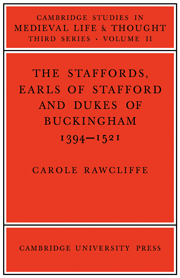Book contents
- Frontmatter
- Contents
- Dedication
- Acknowledgements
- Abbreviations
- Introduction
- 1 THE RISE OF THE STAFFORD FAMILY, 1343–1460
- 2 THE SECOND AND THIRD DUKES OF BUCKINGHAM, 1460–1521
- 3 THE MANAGEMENT OF THE STAFFORD ESTATES, 1438–1521
- 4 THE FIRST DUKE OF BUCKINGHAM'S HOUSEHOLD AND RETINUE, 1438–1460
- 5 CHANGES IN THE DUCAL LIFESTYLE, 1460–1521
- 6 THE FINANCES OF THE STAFFORDS, 14OO–1473
- 7 THE FINANCES OF THE STAFFORDS, 1473–1521
- 8 THE STAFFORDS AND THEIR COUNCIL
- 9 THE STAFFORDS AND THE COMMON LAW
- CONCLUSION
- APPENDICES
- Manuscript Sources
- Printed Sources
- Index
8 - THE STAFFORDS AND THEIR COUNCIL
Published online by Cambridge University Press: 07 October 2011
- Frontmatter
- Contents
- Dedication
- Acknowledgements
- Abbreviations
- Introduction
- 1 THE RISE OF THE STAFFORD FAMILY, 1343–1460
- 2 THE SECOND AND THIRD DUKES OF BUCKINGHAM, 1460–1521
- 3 THE MANAGEMENT OF THE STAFFORD ESTATES, 1438–1521
- 4 THE FIRST DUKE OF BUCKINGHAM'S HOUSEHOLD AND RETINUE, 1438–1460
- 5 CHANGES IN THE DUCAL LIFESTYLE, 1460–1521
- 6 THE FINANCES OF THE STAFFORDS, 14OO–1473
- 7 THE FINANCES OF THE STAFFORDS, 1473–1521
- 8 THE STAFFORDS AND THEIR COUNCIL
- 9 THE STAFFORDS AND THE COMMON LAW
- CONCLUSION
- APPENDICES
- Manuscript Sources
- Printed Sources
- Index
Summary
Every great landowner relied heavily upon an inner circle of administrative staff, lawyers and influential retainers to whom he could turn for advice and help in the running of his estates and the conduct of his business affairs. The Staffords had particular need of a council to supervise the organisation of their large household and eight scattered receiverships; but whereas the first Duke of Buckingham was evidently content to leave all but the most important decisions to the senior personnel and legal advisers who made up his council, the third Duke had more ambitious plans for this long-established and versatile institution.
Very little is known about the work and composition of magnate councils during the fifteenth century, although it seems that these advisory and executive bodies differed from the better documented Duchy of Lancaster council only in the more limited scope of their judicial powers. The Duchy council met regularly in London to debate financial, administrative and legal matters, while smaller commissions travelled around the estates. This was a fairly general practice which often caused friction at a local level and sometimes led to more serious disagreements over the interpretation of franchises. Contemporary sources reveal a deep-seated antagonism towards baronial councils: in 1391, for example, the Commons complained that the nobility was encroaching upon questions of tenure and real estate which ought properly to have been settled at common law.
- Type
- Chapter
- Information
- The Staffords, Earls of Stafford and Dukes of Buckingham1394–1521, pp. 144 - 163Publisher: Cambridge University PressPrint publication year: 1978



